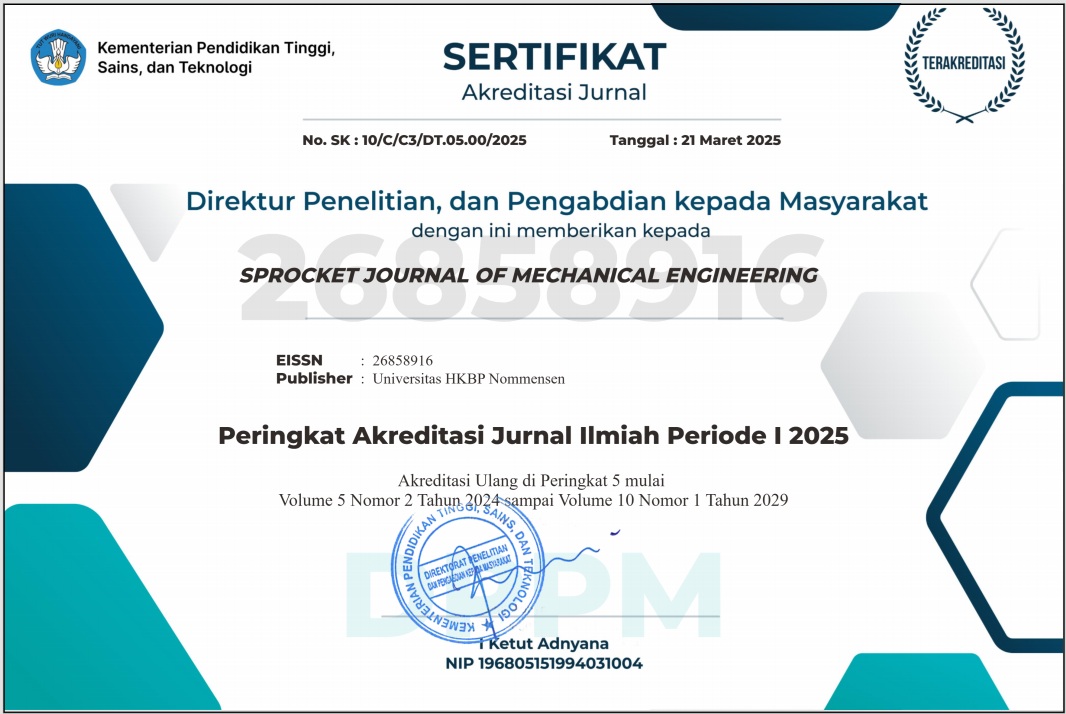Pengaruh Suhu Kondensasi Pada Produksi Asap Cair Dari Biomassa Tempurung Kelapa Dengan Proses Pirolisis
Abstract
Tujuan penelitian ini menguji secara eksperimen alat kondensasi asap hasil pirolisa dari biomassa tempurung kelapa. Proses pirolisia sejatinya adalah proses pembakaran tidak langsung atau proses pemanasan pada suhu tinggi (200 – 450 oC) yang menghasilkan uap panas atau sering disebut dengan uap pirolisis ataupun volatiles. Dengan melalukan pendinginan maka sebagaian uap panas akan berubah menjadi cairan atau sering disebut dengan asap cair, dan yang tidak dapat mencair atau disebut dengan gases yang sifatnya dapat terbakar. Panas untuk proses pirolisa yang digunakan adalah LPG menggunakan burner. Biomassa berupa potongan-potongan tempurung kelapa dengan ukuran rata-rata 5 cm x 5 cm digunakan sebagai bahan baku, dengan terlebih dahulu dikeringkan menggunakan panas matahari hingga mencapai kekeringan standar agar menghasilkan volatiles yang cukup banyak. Volatiles yang berada pada suhu tinggi dengan segera harus mengalami proses pendinginan agar berubah wujud menjadi kondensat pirolisis atau asap cair.
Sistem pendinginan yang digunakan berbentuk koil/spiral dari pipa kuningan dengan diameter 10 mm, 5 gulungan (loop) dan diletakkan vertikal didalam tabung pendingin. Begitu uap panas pirolisa masuk kedalam sistem pendingin, panas laten yang dimiliki uap pirolisis dengan segera diserap oleh air pendingin dan suhunya menurun hingga mendekati suhu saturasinya sehingga proses kondensasi dapat berlangsung. Kondensor tabung-koil spiral vertikal dapat menjadi solusi untuk masalah pendinginan uap panas pirolisis bila direncanakan dengan tepat. Kondensor jenis ini sangat sederhana dan mudah dalam hal perawatan dan perbaikan. Suhu cairan pendingin dengan mudah dapat di control dan dipertahankan dengan menggunakan es-batu. Hasil eksperimen menunjukkan bahwa pengaruh suhu terhadap proses kondensasi sangat penting. Suhu pendinginan yang rendah dibandingkan dengan suhu pendinginan konvensional menghasilkan cairan pirolisis yang lebih baik terbukti dari warna cairan yang diperoleh berwarna kekunin-kuningan.
References
[2] Rozum, J., Smoking | Liquid Smoke (Smoke Condensate) Application, in Encyclopedia of Meat Sciences (Second Edition), M. Dikeman and C. Devine, Editors. 2014, Academic Press: Oxford. p. 315-320.
[3] Papari, S. and K. Hawboldt, A review on condensing system for biomass pyrolysis process. Fuel Processing Technology, 2018. 180: p. 1-13.
[4] Latumahina, F.S., G. Mardiatmoko, and M. Tjoa, Penggunaan Biopestisida Nabati: untuk Pengendalian Hama Tanaman Kehutanan (Peluang Pengembangan Kelompok Tani). 2021: Penerbit Adab.
[5] Chalermsan, Y. and S. Peerapan, Wood vinegar: by-product from rural charcoal kiln and its role in plant protection. Asian Journal of Food and Agro-Industry, 2009. 2(Special Issue).
[6] Berrueta, V.M., R.D. Edwards, and O.R. Masera, Energy performance of wood-burning cookstoves in Michoacan, Mexico. Renewable Energy, 2008. 33(5): p. 859-870.
[7] Illerup, J.B., et al., Performance of an automatically controlled wood stove: Thermal efficiency and carbon monoxide emissions. Renewable Energy, 2020. 151: p. 640-647.
[8] Rahbar, K., et al., Feasibility study of power generation through waste heat recovery of wood burning stove using the ORC technology. Sustainable Cities and Society, 2017. 35: p. 594-614.
[9] Simanjuntak, J.P., K. Al-attab, and Z. Zainal, Hydrodynamic flow characteristics in an internally circulating fluidized bed gasifier. Journal of Energy Resources Technology, 2019. 141(3).
[10] Simanjuntak, J.P. and Z.A. Zainal, Experimental study and characterization of a two-compartment cylindrical internally circulating fluidized bed gasifier. Biomass and Bioenergy, 2015. 77: p. 147-154.
[11] Simanjuntak, J.P., E. Daryanto, and B.H. Tambunan. Producer gas production of Indonesian biomass in fixed-bed downdraft gasifier as an alternative fuels for internal combustion engines. in Journal of Physics: Conference Series. 2018: IOP Publishing.
[12] Wang, Z., J. Cao, and J. Wang, Pyrolytic characteristics of pine wood in a slowly heating and gas sweeping fixed-bed reactor. Journal of Analytical and Applied Pyrolysis, 2009. 84(2): p. 179-184.
[13] Yorgun, S. and D. Yıldız, Slow pyrolysis of paulownia wood: Effects of pyrolysis parameters on product yields and bio-oil characterization. Journal of Analytical and Applied Pyrolysis, 2015. 114: p. 68-78.
[14] Tambunan, B.H. and simanjuntak, J.P, Pyrolysis of Plastic Waste into The Fuel Oil. CCER, 2018: p. 499.
[15] Lamarche, P., et al., Modelling of an indirectly heated fixed bed pyrolysis reactor of wood: Transition from batch to continuous staged gasification. Fuel, 2013. 106: p. 118-128.
[16] Tamburini, D., et al., Using analytical pyrolysis and scanning electron microscopy to evaluate charcoal formation of four wood taxa from the caatinga of north-east Brazil. Journal of Analytical and Applied Pyrolysis, 2020. 151: p. 104909.
[17] Wang, Z., et al., Pyrolysis of pine wood in a slowly heating fixed-bed reactor: Potassium carbonate versus calcium hydroxide as a catalyst. Fuel Processing Technology, 2010. 91(8): p. 942-950.
[18] Burhenne, L., M. Damiani, and T. Aicher, Effect of feedstock water content and pyrolysis temperature on the structure and reactivity of spruce wood char produced in fixed bed pyrolysis. Fuel, 2013. 107: p. 836-847.
[19] Sobek, S. and S. Werle, Kinetic modelling of waste wood devolatilization during pyrolysis based on thermogravimetric data and solar pyrolysis reactor performance. Fuel, 2020. 261: p. 116459.
[20] Sadhukhan, A.K., P. Gupta, and R.K. Saha, Modelling of pyrolysis of large wood particles. Bioresource Technology, 2009. 100(12): p. 3134-3139.
[21] Gadkari, S., B. Fidalgo, and S. Gu, Numerical investigation of microwave-assisted pyrolysis of lignin. Fuel Processing Technology, 2017. 156: p. 473-484.
[22] Salema, A.A., et al., Microwave dielectric properties of Malaysian palm oil and agricultural industrial biomass and biochar during pyrolysis process. Fuel Processing Technology, 2017. 166: p. 164-173.
[23] Nhuchhen, D.R., et al., Characteristics of biochar and bio-oil produced from wood pellets pyrolysis using a bench scale fixed bed, microwave reactor. Biomass and Bioenergy, 2018. 119: p. 293-303.
[24] Guzelciftci, B., K.-B. Park, and J.-S. Kim, Production of phenol-rich bio-oil via a two-stage pyrolysis of wood. Energy, 2020. 200: p. 117536.
[25] Urrutia, R.I., et al., Pyrolysis liquids from lignocellulosic biomass as a potential tool for insect pest management: A comprehensive review. Industrial Crops and Products, 2022. 177: p. 114533.
[26] Pollard, A.S., M.R. Rover, and R.C. Brown, Characterization of bio-oil recovered as stage fractions with unique chemical and physical properties. Journal of Analytical and Applied Pyrolysis, 2012. 93: p. 129-138.

This work is licensed under a Creative Commons Attribution 4.0 International License.
Penulis yang menerbitkan dengan SPROCKET JOURNAL OF MECHANICAL ENGINEERING menyetujui ketentuan berikut :
- Penulis memegang hak cipta dan memberikan jurnal hak penerbitan pertama dengan karya yang dilisensikan secara bersamaan di bawah Lisensi Internasional Creative Commons Atribusi 4.0 . yang memungkinkan orang lain untuk berbagi karya tersebut dengan pengakuan atas kepengarangan karya dan penerbitan awal dalam jurnal ini.
- Penulis dapat membuat pengaturan kontraktual tambahan yang terpisah untuk distribusi non-eksklusif atas versi jurnal yang diterbitkan dari suatu karya (misalnya, mempostingnya ke repositori institusional atau menerbitkannya dalam sebuah buku), dengan pengakuan atas penerbitan awalnya di jurnal ini.
- Penulis diizinkan dan didorong untuk mengunggah karya mereka secara daring (misalnya, di repositori institusi atau di situs web mereka) sebelum dan selama proses penyerahan, karena hal ini dapat mengarah pada pertukaran yang produktif, serta kutipan yang lebih awal dan lebih banyak dari karya yang diterbitkan (Lihat Pengaruh Akses Terbuka ).






.png)
.png)

